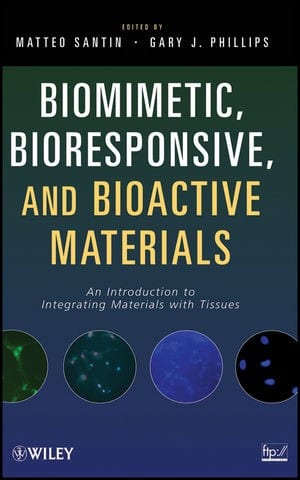 Biomimetic, Bioresponsive, and Bioactive Materials: An Introduction to Integrating Materials with Tissues
Biomimetic, Bioresponsive, and Bioactive Materials: An Introduction to Integrating Materials with Tissues
Matteo Santin (Editor), Gary J. Phillips (Editor)
ISBN: 978-0-470-05671-4
Hardcover
248 pages
US $99.95
Click here for more information
Reviewed by Professor Magnus Bergkvist, State University of New York
Medical devices capable of restoring functionality of limbs and vascular systems have revolutionized health care over last four decades. The function and use of biomedical implants has developed tremendously over this period, which have saved numerous of patients’ lives and improved the quality of life for an aging population worldwide. In parallel, knowledge has been accumulated of how the human body responds to these materials and what their structural requirements and limitations are. One thing that has become clear is that interdisciplinary teams combining materials science, cell biology, biotechnology, clinical science etc. is needed to develop the next generation “smart” materials for medical devices.
This book, “Biomimetic, Bioresponsive, and Bioactive Materials – An Introduction to Integrating Materials with Tissues”, provides an overview of the field with chapters from various expert authors. It present the advances made in medical device materials and discuss some of the challenges ahead. An overview of the fundamental tissue systems and cell biology involved with tissue repair and integration is also included. The focus of the book is primarily on materials and systems that has been clinically successful, where the last chapter offer an insight into emerging materials that could have translational value. The book is comprised of seven chapters where each chapter ends with a series of questions or exercises for the reader to test comprehension of the presented content.
The first chapter offers a brief historical overview of common biomaterials and introduces the terms “bioinert”, “bioactive” and “bioresponsive’ to the reader. The chapter also present the fundamental phases of tissue regeneration and how new materials can improve by integrating “biomimetic” elements to facilitate cell response and repair.
The second chapter deals with the structure and repair of soft tissue. The basic categories of soft tissues are explained and each tissue type is discussed in terms of structure, function and repair/renewal. The third chapter continues with giving an introduction of the structure and function of hard tissue, i.e. bone and cartilage.
Chapter four focus on phosphorylcholine (PC) containing polymers and starts off with a short historical background, followed by polymer architecture and physicochemical properties. The later sections present the biomedical applications of PC-polymers, such as cardiovascular stents and drug delivery.
The next two chapters provide an overview of common metal and ceramic systems used for biomedical implants, respectively. The fundamental properties and fabrication approaches for the material systems are presented with some discussion of suitability and requirements for their use. Chapter five concentrates on metals and explains important properties for metallic implants such as stiffness, strength, and corrosion resistance. The biocompatibility of metals is discussed and a table of ISO certified materials is included. The chapter continues to outline various surface treatments of metals (roughening etc.) to facilitate biointegration. Chapter six is devoted to bioceramic materials and offer insight on biostable, and bioactive/resorbable ceramics, principally silica and phosphate based matrixes. Common types of glass-ceramics and their properties and processing are presented, followed by a short section of emerging areas with incorporation of drugs and other bioactive components in the matrixes.
Chapter seven gaze toward the future and discuss emerging trends in biomaterial integration, and provide specific examples of specific areas that need new approaches and strategies to develop the next generation biomedical devices. Materials that appear likely to move on to translational applications, such as dendrimers and polymer systems incorporating biomimetic ECM components are briefly mentioned.
The book serves an audience on an intermediate level with interest in this area, which could be graduate level medical students, material science students, or professionals new to the field. It provides a broad overview over common materials and issues associated with tissue engineering and current clinical implants that leave the reader wanting more.

















